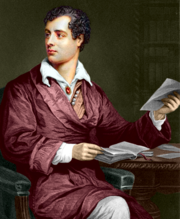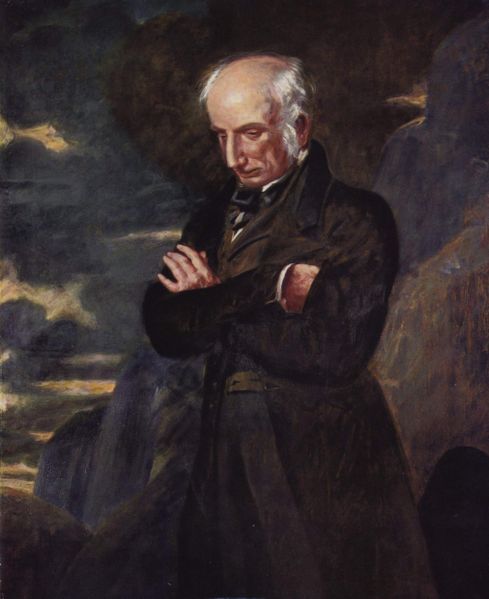LORD
BYRON
VS
VS
VS
WILLIAM WORDSWORTH

George Gordon Lord Byron (1788-1824)
She Walks in Beauty
1She walks in beauty, like the night
2 Of cloudless climes and starry skies;
3And all that's best of dark and bright
4 Meet in her aspect and her eyes:
5Thus mellow'd to that tender light
6 Which heaven to gaudy day denies.
7One shade the more, one ray the less,
8 Had half impair'd the nameless grace
9Which waves in every raven tress,
10
Or softly lightens o'er her face;
11Where
thoughts serenely sweet express
12
How pure, how dear their dwelling-place.
13And
on that cheek, and o'er that brow,
14
So soft, so calm, yet eloquent,
15The
smiles that win, the tints that glow,
16
But tell of days in goodness spent,
17A
mind at peace with all below,
18
A heart whose love is innocent!
Publication date: 1815
Poem source: http://rpo.library.utoronto.ca/poem/365.html

William
Wordsworth (1770-1850)
She
Was a Phantom of Delight
1 She was a Phantom of delight
2When first she gleamed upon my sight;
3A lovely Apparition, sent
4To be a moment's ornament;
5Her eyes as stars of Twilight fair;
6Like Twilight's, too, her dusky hair;
7But all things else about her drawn
8From May-time and the cheerful Dawn;
9A dancing Shape, an Image gay,
10To
haunt, to startle, and way-lay.
11I
saw her upon nearer view,
12A
Spirit, yet a Woman too!
13Her
household motions light and free,
14And
steps of virgin-liberty;
15A
countenance in which did meet
16Sweet
records, promises as sweet;
17A
Creature not too bright or good
18For
human nature's daily food;
19For
transient sorrows, simple wiles,
20Praise,
blame, love, kisses, tears, and smiles.
21And
now I see with eye serene
22The
very pulse of the machine;
23A
Being breathing thoughtful breath,
24A
Traveller between life and death;
25The
reason firm, the temperate will,
26Endurance,
foresight, strength, and skill;
27A
perfect Woman, nobly planned,
28To
warn, to comfort, and command;
29And
yet a Spirit still, and bright
30With
something of angelic light.
Publication date: 1807
Poem source: http://rpo.library.utoronto.ca/poem/2366.html
The two poems I am going to compare are: “She was a Phantom of Delight”
by William Wordsworth, and “She walks in beauty” by Lord Byron. The
main particula-rity that the poems have in common is that, in both cases,
the poets are dealing with the description of a woman. However, both poems
seem more like a metaphorical portrayal about angelical figures than about
real women themselves. Moreover, as we can see, both poets use the word “she”
to write about the women they are des-cribing, so they do not give any women’s
name and, at the same time, they make their poems look more like a reflection
than a direct and dedicated description to the women themselves. Nevertheless,
both women are known by the poets, because one is William Wordsworth´s
wife (Mary Worthsworth) and the other one is Lord Byron’s cousin: “Mrs.
Wilmot, whom he met at a party in a mourning dress of spangled black” (http://rpo.library.utoronto.ca/poem/365.html)
In the poems, the authors
play with the contrast between light and darkness. In both poems, the women
are surrounded by darkness, the night, the black colour…. and they are
presented as the light that shines that darkness (specially their eyes).
For example, in Lord Byron’s poem, the whole text deals with the image
that in this world of darkness, the woman he is referring represents and
catches the light that is nowhere else (lines 3-6). And in Wordsworth´s
poem, the author also uses the image of the woman and her eyes to play with
the metaphor that she was the light among the darkness (at least when they
first met) (lines 5-6). In both poems there is a link between the authors´
eyes and the women’s eyes, which also shows the connection there is between
the authors´ soul and the women’s soul. The poets look through the
women’s eyes to really find the light among all that darkness and the truth
of who they really are.
Another important point that the
poems have in common is that the authors relate the vision they have of
the women at first sight. They make their reflection and know everything
they know about both women just looking once to their aspect (the visual
factor and the first impression acquire much importance in the texts.) For
example: Lord Byron presents us the woman just referring to what he is contemplating;
just looking her eyes (line 4), her face (lines 10, 13) her smiles (line
15)… and then he writes about what that image evokes to him, but he does
not write about any action. In Wordsworth´s poem, the visual aspect
is also very important, (as we can see in lines 2, 11, 21…), but, however,
we can appreciate a clear sign of time passing along the poem that is marked
in the different stanzas. The author begins each stanza (lines 1, 11 and
21) narrating the way he watches the woman, and he plays with the concept
of distance and the verb tenses to indicate the pass of time. Besides, although
Wordsworth only focuses, as Byron, on the first impression and strictly in
the image of the woman, he also introduces some reflections that let us think
that the author knows the woman better than Byron does (at least just by
reading the poem). For example, lines 15-20 show us that the author really
knows the woman very well: he writes about daily things and especially in
lines 19-20, he makes a clear allusion to the relationship they have had
and the time they have spent together.
Despite the fact that both poets
give a very positive vision about the women, they treat that vision from
a different perspective, although both arrive to the same conclusion. Lord
Byron presents us the woman like she was an angel. He only uses adjectives
and expressions to describe her purity and innocence: “grace” (L. 8), “How
pure, how dear their dwelling-place” (L.12), (Lines 15-16), and, specially,
the final conclusion which gives us the real impression the author has about
the wo-man’s image: “A heart whose love is innocent” (L. 18). Nevertheless,
Wordsworth´s vision is slightly different. The first thing that catches
your attention is that he describes the woman like she was a spirit or a
ghost: “Phantom” “Spirit” “Appari-tion”… and this is not very typical. It
looks more like a kind of gothic description than a typical romantic love
poem. In my opinion it is very weird to describe a wo-man like she was a
“Creature” or a “Being” that walks around the house like she was a ghost.
Though, the strange factor is that the author links these “negative” words
with “positive” adjectives and he gives us the impression of a curious contrast:
“A lovely Apparition” (L.3), “A dancing Shape, an Image gay” (L.9)… and specially
the final couplet: “And yet a Spirit still, and bright/ With something of
angelic light”, where, as Byron, the author makes a connection between the
image and the physical figure of the woman and her metaphysical presence.
. As I have commented before, the
concept of time is very important in both poems. For instance, Lord Byron
describes the woman only focusing in a specific moment: the present, here
and now. Since the beginning with “She walks in beauty” he marks
the present situation and, although he develops his description, we can
appreciate that he is only writing about that moment. However, in Wordsworth´s
poem, there is a progression. He starts the poem when he first saw the
woman and he develops his knowledge and portrayal about the woman just
as time passes. The curious fact is that, although both poets develop their
writings in a very different way: Lord Byron narrates just a point in time
by witnessing the girl only in a positive way; and that Wordsworth follows
a kind of chronological line introducing positive aspects, but also negative
ones… the two poets arrive to the same conclusion: the last lines of both
poems are very similar: the admiration and recognition that those women
are like angelical beings.
In conclusion: In spite of the fact
that both poems seem the typical love romantic poems, it is curious to
analyse how both poets treat the same topic and get to the same conclusion,
but the development of their poems is slightly different. And, of course,
the feature that has caught my attention is that Wothsworth treats the woman,
like she was a ghost, like she was a figure in the middle between life and
death… and, although I think that the poet captures and is influenced by
the gothic references, it is not very typical to describe the woman you love
that way. Even so, both poets are able to give the impression that the women
they are portraying are beyond the physical nature, despite the fact that
they only write about the image and the impression they have about the women
just by witnessing them.
THE TYGER
TO A LADY
THE LABORATORY
THE BLESSED
DAMOZEL


